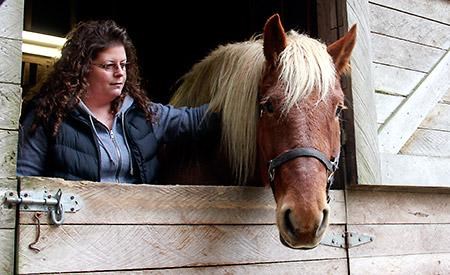Now that Mist and Streak have found greener acres in retirement, Powell River Therapeutic Riding Association is looking for horses, but finding the right horse takes time and money.
In September, Colleen and Hal Mudry adopted Mist and Streak and since then the association has been on the hunt for horses to replace the old-timers.
The scouting process for finding suitable horses can be long and expensive. Not just any horse can be a therapeutic riding horse.
“You want them to be calm, gentle and okay with people around,” said Joyce Lennox, the association’s program administrator. “Horses are either fight or flight.” She explained that when horses are startled they either run away or kick. “You don’t want that to occur in class. So it takes a trial to get them sensitized to that. They tell us pretty clearly if they like it or they don’t.”
Lennox and her scouts, Shannon Durant and Shivaun Gingras, use the term “bombproof,” to describe a horse that can handle the rigours of therapeutic riding. When the scouts are examining a horse they specifically look for this quality, by “waving their coats or carrot sticks” and “throwing colourful balls at them and putting buckets under their feet.” If the horse doesn’t get upset by this, then they are on their way to being chosen.
“It takes a special kind of horse to put up with all that,” said Lennox. Therapeutic riding horses need to be able to deal with a lot of inputs, she added.
Once the horses are brought into the association’s barn, they aren’t put into classes right away. The length of the trial depends largely on the horse’s background and his or her personality. For one of their current horses, Tye, it was quite quick, at six months, but for other horses it takes more time.
In the past, Lennox said that people would free lease their horse to the association. Free leases are agreements where owners allow the riding association to use their horse for free but have to pay for the horse’s maintenance and food, which can cost up to $5,000 per year per horse.
Recently the association has received funding from Powell River Health-Care Auxiliary for purchasing horses, but that doesn’t make the process of getting new horses into the barn any less work.
“It’s a really huge investment of time, effort and money,” said Lennox. There’s a time factor in going back and forth to scout them, then there’s the cost of the ferries, she explained.
Lorraine Hansen, president of the auxiliary, said the auxiliary has purchased three horses and an equicizer, a wooden horse that helps riders develop balance for therapeutic riding.
“We are also committed to purchase another horse when they find the appropriate gentle horse that will fit into their program,” said Hansen. The auxiliary is restricted to only being able to fund the purchase or horses or equipment, so the association needs to find other funding for taking care of the horses.
Currently, the association is putting its hopes on a horse named Breeze who comes from a farm near Nanoose Bay on Vancouver Island. Lennox said she thinks “she’s going to work out just fine.” She anticipates Breeze being included in the new sessions that will start in January.
Meanwhile, Lennox’s scouts will be looking at online equine registries and following leads on their therapeutic riding networks looking for another suitable candidate.



